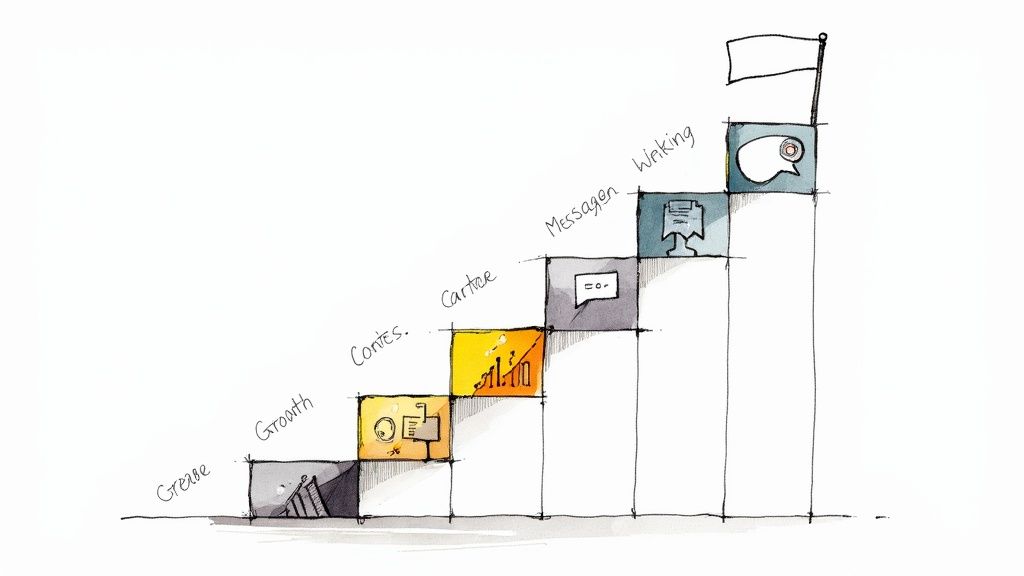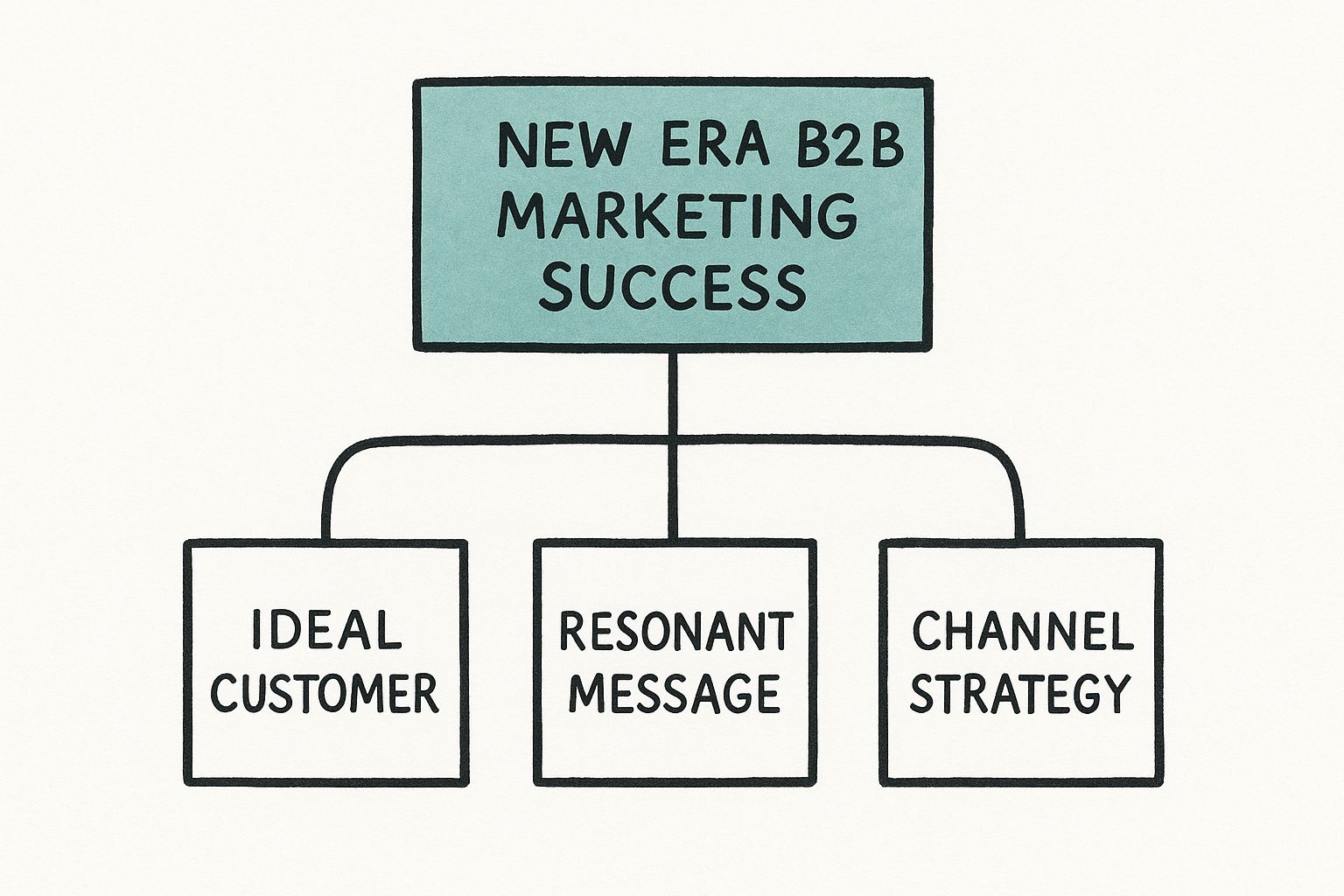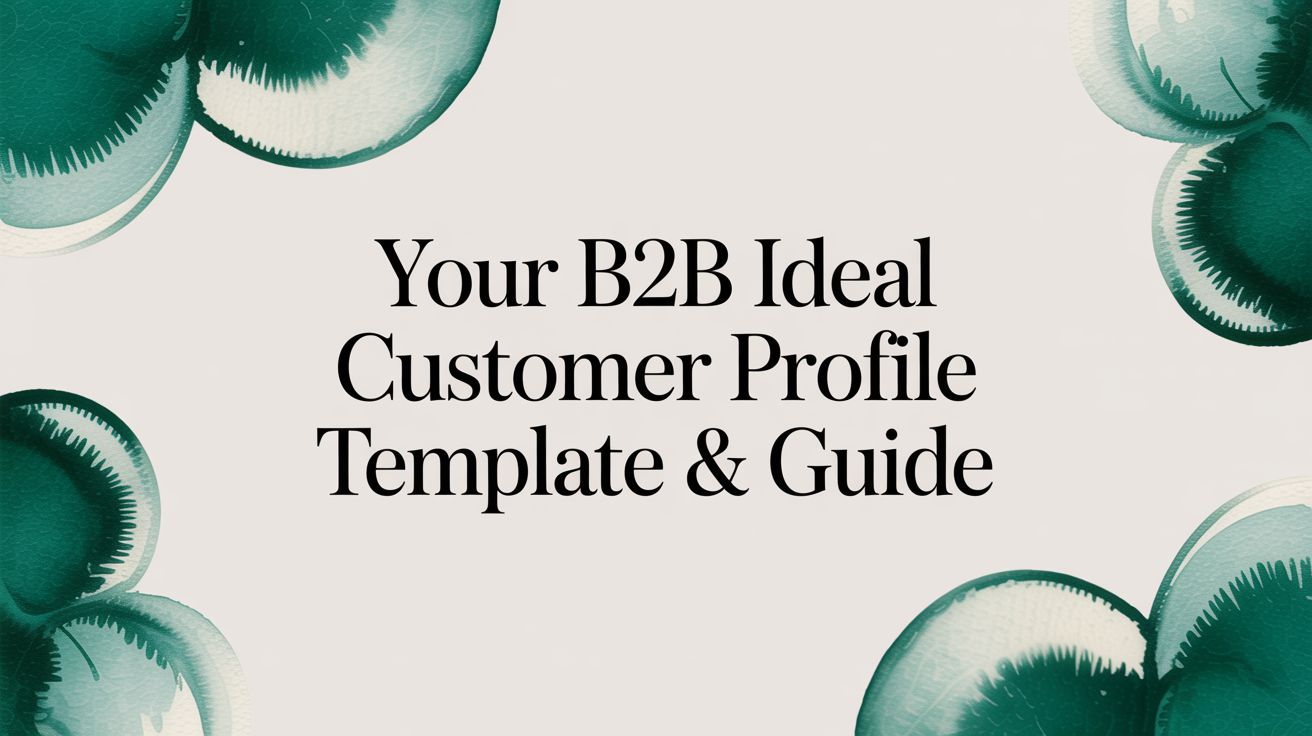Mastering B2B Business Marketing for Growth
October 18, 2025

Effective B2B business marketing isn't about selling to companies anymore. It's about forging strategic, value-driven partnerships. Think of it less like a simple transaction and more like an architect designing a resilient bridge connecting two organizations for the long haul.
The New Era of B2B Business Marketing
Success in modern B2B requires precision, a deep understanding of who you're talking to, and a clear strategic blueprint. This isn't about casting a wide net and hoping for the best. It's about meticulously building relationships founded on trust and tangible business outcomes. The entire approach has shifted from pushing products to pulling in ideal partners by solving their most pressing problems.
This modern framework boils down to a few core pillars. When these are executed well, they work together to create a powerful engine for growth and customer loyalty.
- Understanding Your Ideal Customer: You need to pinpoint the exact companies—and the key decision-makers within them—who will get the most value from your solution.
- Crafting a Resonant Message: This means moving beyond a simple list of features to clearly articulate the specific value and outcomes you deliver. What problem do you actually solve?
- Choosing the Right Channels: Your message has to land where your audience is already engaged and receptive. It’s about being in the right place at the right time.
This infographic breaks down how these foundational pillars support modern B2B marketing success. As you can see, a winning strategy always starts with the customer. It's then powered by a clear, compelling message and delivered through a well-defined channel strategy.
As you can see, a winning strategy always starts with the customer. It's then powered by a clear, compelling message and delivered through a well-defined channel strategy.
The Digital Shift in B2B Deals
The importance of a digitally-focused strategy is growing rapidly. Projections show that by 2025, digital channels will dominate even the highest-value B2B transactions. In fact, it's predicted that over 50% of B2B deals valued at $1 million or more will be processed digitally.
This highlights a clear move away from traditional, siloed marketing toward a unified, performance-driven approach that directly supports sales. You can explore more about this B2B marketing transformation and its implications for how businesses operate.
Modern B2B marketing is about becoming an indispensable partner. When you consistently solve your customer's problems, you build relationships that transcend simple transactions and foster long-term loyalty and growth.
This guide will give you an actionable roadmap to master these fundamentals and start building your own bridge to lasting business success.
Building Your Foundation with Market Segmentation
Before you write a single line of ad copy or design a landing page, you must answer the most fundamental question in marketing: Who are we talking to? This is where market segmentation comes in, and it's the bedrock of any successful B2B marketing strategy. We’re moving beyond generic customer profiles to zero in on the specific companies that need what you’re selling.
Think of it like a master locksmith crafting a key for a high-security lock. A generic blank from the hardware store won't even turn. You need a key with precise grooves and cuts, designed for that one specific mechanism. In the same way, a generic marketing message won't open the door to a high-value B2B client. Your marketing has to be the perfectly cut key, shaped to fit their unique challenges and business needs.

This process isn't just about making your marketing more efficient; it's about making it brutally effective. Getting this right starts with defining your target market to make sure every dollar and every minute you spend is a smart investment.
Going Beyond Basic Demographics
Real B2B segmentation means drilling down through layers of data to get a crystal-clear picture of your ideal customer. It’s about looking at the attributes that define a business, not just a person. When you do this, you start seeing patterns and opportunities that your competitors miss.
We can break these layers down into three main categories:
- Firmographics: This is the basic company DNA. Think industry, annual revenue, number of employees, and where they're located. For example, a cybersecurity firm might decide to only target financial services companies in North America with over 500 employees.
- Technographics: This is about the technology stack a company uses. Knowing a prospect runs on Salesforce, uses AWS for their cloud infrastructure, or relies on a specific project management tool tells you a great deal about their operational maturity and where you might fit in.
- Behavioral Data: This layer tracks how a company interacts with you. Did someone from their team download a white paper? Did a key decision-maker attend your last webinar? This data is pure gold because it signals active interest and buying intent.
By combining these data points, you move from a flat, one-dimensional guess to a rich, multi-dimensional view of your target accounts. For a much deeper dive, our complete guide to B2B market segmentation covers more advanced techniques.
Segmentation allows you to speak directly to your audience’s most urgent problems. When a prospect feels like your message was created just for them, you stop being a vendor and start becoming a potential partner.
Applying Segmentation Criteria in Practice
Let’s make this real. A well-defined segment should guide everything you do—from the blog posts you write to the channels you use to promote them. It’s the strategic filter for all your marketing decisions.
To see how these different criteria come together, it helps to look at what each type of data helps you accomplish. Each one serves a distinct purpose.
Key B2B Market Segmentation Criteria
Ultimately, great segmentation is about precision. It ensures your marketing efforts are not just loud, but are actually heard by the exact people who have the power to say "yes." This targeted approach is how you build stronger connections and drive real, meaningful business growth.
Crafting Your Message and Value Proposition
Knowing who you’re talking to is only half the battle. Now you have to speak their language. Once you’ve segmented your market, your next challenge is to craft a message that doesn’t just describe what you do, but inspires action.
This is where your value proposition and positioning become the sharpest tools in your kit.
Positioning isn’t about your product’s features. It’s about the specific, unshakeable idea you own in your customer's mind. When they’re facing a problem you solve, what thought or feeling immediately comes to mind about your brand? Are you the most secure option? The most efficient? The absolute best for scaling teams?
Your job is to definitively answer their unspoken question: "Of all the choices I have, why should I pick you?"
From Features to Business Outcomes
One of the most common traps in B2B marketing is getting stuck on features. We love to list what our software can do—"real-time analytics dashboard," "AI-powered workflow automation," "integrates with 50+ platforms." While those details matter eventually, they aren't what a busy executive is buying.
They're buying outcomes. They're buying a fix for an expensive, persistent problem. They're buying a better, more profitable future for their company.
Your job is to translate every feature into a tangible benefit and, ultimately, a strategic outcome. A feature only matters if it helps a client hit one of their core business goals.
For instance, stop talking about the tool and start talking about the result.
- Feature: "AI-powered workflow automation."
- Benefit: "It cuts down the time your team spends on manual data entry."
- Outcome: "This frees up your best people to focus on strategic work, slashing operational costs by up to 25% and getting projects delivered faster."
See the difference? That shift moves the conversation from your product’s specs to your customer’s success. That’s a far more compelling story to tell.
Building a Value Proposition That Connects
Your value proposition is the heart of your message. It’s a clear, concise promise of the value a customer will get by choosing you. It has to be specific, zeroed in on their pain, and make it obvious why you’re different from the rest.
A truly effective B2B value proposition has three key ingredients:
- The Target Customer and Their Problem: Who is this for, and what big, frustrating challenge are they dealing with? This proves you understand them.
- Your Unique Solution: What is your product, and how does it solve that problem in a way no one else can? This is your secret sauce.
- The Quantifiable Outcome: What clear, measurable result can they expect? This makes the value real and undeniable.
You can think of it like a simple formula: We help [Ideal Customer Profile] solve [Specific Problem] with our [Unique Solution], enabling them to achieve [Quantifiable Outcome].
A Framework for Clear Messaging
Getting this level of clarity doesn't happen by accident. You can’t just guess what resonates; you need a structured process to define, test, and refine your messaging. For anyone serious about nailing this, it’s worth learning how to build a B2B messaging framework that works to get your entire company telling the same powerful story.
Let’s put this into practice with a hypothetical SaaS company that sells supply chain software.
- Weak Value Proposition: "We sell an advanced logistics management platform."
- Strong Value Proposition: "We provide enterprise manufacturing firms with a predictive logistics platform that reduces shipping delays by 30% and eliminates stockout risks."
The second version is instantly more powerful. It names the audience (enterprise manufacturing), hits on the pain points (delays, stockouts), and promises a specific, highly desirable outcome. That’s the kind of clarity that cuts through the noise and actually connects with the decision-makers you need to reach.
Fueling Growth with a B2B Content Strategy
If your messaging and value proposition are the fuel for your B2B business, then your content is the engine that drives everything forward. It's how you educate your audience, build genuine trust, and keep a steady stream of qualified leads coming your way.
But let's be clear: a powerful content strategy is much more than publishing a few blog posts. It’s a deliberate framework designed to solve real, pressing problems for your ideal customers.
Great content doesn't just sell; it serves. When you consistently show up with valuable insights and solutions, you stop being just another vendor and become the go-to resource in your industry. This shift makes the entire sales process feel more natural because you've already built authority and goodwill long before the first sales call.

Mapping Content to the Buyer’s Journey
An effective content strategy is never random. It’s meticulous. It involves mapping specific types of content to the distinct stages of the B2B buyer's journey. Your goal is to guide prospects from their first inkling of a problem all the way to a confident decision, using content that feels perfectly timed and relevant.
Think of it like a conversation. You wouldn't open a first meeting by diving into contract terms. You'd get to know them, understand their challenges, and then propose a solution. Your content needs to follow that same logical, human progression.
Here’s a simple way to think about aligning your content with each critical stage:
- Awareness Stage: At this point, the prospect is just starting to realize they have a problem, but they probably haven't even put a name to it yet. Your goal is to educate them, not sell. Blog posts, industry reports, and short educational videos are perfect for helping them define their pain point.
- Consideration Stage: Now they've defined their problem and are actively hunting for solutions. This is your chance to offer more in-depth, valuable assets like white papers, webinars, detailed case studies, and eBooks that explore different ways to solve their issue.
- Decision Stage: The prospect is now comparing vendors and is ready to make a choice. The content you offer here should make it an easy decision to choose you. This is the time for product demos, free trials, transparent pricing pages, and comparison guides that highlight your unique advantages.
The Power of Authority-Building Assets
While blog posts are fantastic for SEO and catching top-of-funnel attention, it's the deeper, more substantial assets that build unshakable authority and generate high-quality leads. These pieces offer a level of detail that solves complex, thorny problems for your audience.
Content is the currency of trust. By generously sharing your expertise, you create a relationship built on value long before you ever ask for a sale.
White papers and eBooks are prime examples. They let you take a deep dive into a specific industry challenge, backing up your insights with hard data and solid research. Webinars are another powerful tool, giving you a platform for live, interactive engagement where you can answer questions in real-time and build a personal connection with potential clients.
But case studies? They might just be the most vital asset in the decision stage. They provide concrete social proof, showing a prospect, "We've already solved this exact problem for a company just like yours." They transform your value proposition from a mere promise into a proven reality.
Building and Scaling Your Content Engine
Creating consistently high-quality content is a major undertaking. That's why having a strategic approach to production isn't just nice—it's essential.
The data backs this up. An overwhelming 83% of B2B content is created to build brand awareness and interest, proving its central role in establishing thought leadership. And since top-ranking pages on Google average around 1,447 words, there's a clear advantage to creating comprehensive, long-form content. To keep up with this demand without sacrificing quality, 84% of businesses now outsource content creation.
To get the most out of every piece you create, you must have a clear, repeatable process. For a detailed guide on creating that system, you can learn more about how to build a B2B content strategy that boosts conversions. A structured approach ensures every article, white paper, and webinar serves a distinct purpose, driving your business goals forward and fueling sustainable growth.
Choosing Your Channels for Maximum Impact
A brilliant message is wasted if it never reaches the people who need to hear it. Once you’ve nailed your value proposition and sketched out a content strategy, the next critical step is picking the right marketing channels to deliver that message. Success in B2B marketing isn’t about being everywhere; it’s about being in the right places, with surgical precision.
Think of it like a skilled angler. A pro knows exactly what kind of fish they’re after. They research where those fish live, what they eat, and when they’re most active. Only then do they head to that specific spot with the right bait and tackle. Channel selection is your strategic fishing trip.
Precision Over Presence: The B2B Philosophy
The goal is to invest your limited time, budget, and creative energy where your ideal customers are already active and open to new ideas. This means you must fight the urge to create a token presence on every platform. Instead, you double down on the channels that promise the highest return for your specific audience. It's a focused approach, and it’s the key to making every marketing dollar count.
You need to figure out the digital and real-world spaces where your target accounts and key decision-makers gather. Are they deep in conversation in specific LinkedIn groups? Do they rely on certain industry publications to stay informed? Getting a handle on these habits is absolutely essential for making smart channel choices.
For a deeper dive into this process, our guide on choosing the right channels for B2B growth lays out a complete framework. It helps ensure your efforts are deliberate investments toward a clear business goal.
High-Impact Channels for B2B Organizations
While the perfect channel mix is unique to every business, a few heavy hitters consistently deliver strong results for B2B companies. These are the channels built for targeted, value-driven communication that connects with a professional audience.
- Search Engine Optimization (SEO): This is foundational. SEO makes sure that when a potential client is actively hunting for a solution to their problem, you’re the one who shows up. It’s the ultimate inbound channel, catching high-intent prospects at the exact moment they need you most.
- LinkedIn Marketing: As the world's biggest professional network, LinkedIn is ground zero for B2B engagement. It's an invaluable tool for building brand authority, connecting directly with decision-makers, and running hyper-targeted ad campaigns based on job titles, industries, and company size.
- Targeted Email Campaigns: Far from being old-school, email is a direct line to your audience. By segmenting your lists and personalizing your messages, you can deliver relevant content—from newsletters to nurture sequences—that guides prospects thoughtfully through their buying journey.
The most effective channel strategy is the one that meets your buyers where they already are. Don't force them to find you; make your brand a visible, valuable part of the communities and platforms they already trust.
As you build out your strategy, it’s also smart to explore top B2B social media marketing strategies to see how different platforms can work together to amplify your reach.
Adopting an Account-Based Marketing Approach
For many B2B companies, especially those chasing high-value deals, Account-Based Marketing (ABM) is a game-changer for focusing resources. Instead of casting a wide net for individual leads, ABM treats each target company as its own "market of one."
This approach flips the traditional marketing funnel.
- Identify High-Value Accounts: You start by hand-picking a specific list of target companies that are a perfect fit for what you offer.
- Personalize Outreach: Marketing and sales teams then work together to create highly personalized campaigns and content, tailored to the unique challenges and stakeholders inside each target account.
- Engage and Build Relationships: The focus shifts from generating a high volume of leads to building deep, meaningful relationships with the key players inside those select companies.
ABM aligns your marketing and sales efforts with a laser-like focus, making sure every dollar is spent on accounts with the highest potential to become major customers. It's the ultimate expression of precision over presence and has become a cornerstone of modern B2B marketing.
Integrating AI into Your B2B Marketing Efforts
Artificial Intelligence isn't a far-off concept anymore. For B2B marketers, it's a practical tool that can amplify your results today. Integrating AI isn't about replacing the smart, creative people on your team; it’s about giving them a toolkit that uncovers deep insights, drives efficiency, and helps you create better experiences for your clients.
Think of AI as a brilliant co-pilot for your marketing team. While your human strategists focus on the big picture—the ultimate destination—AI is in the background, handling thousands of complex calculations in real time. It's constantly analyzing data, adjusting for new variables, and flagging opportunities, allowing your team to make smarter, faster decisions.

From Manual Tasks to Intelligent Automation
One of the first places you'll feel AI's impact is in its ability to take over repetitive, time-consuming tasks that slow down marketing teams. This frees up your best people to focus on what they do best: high-level strategy, creative problem-solving, and building genuine client relationships.
The demand for this kind of efficiency is growing across the B2B world. Recent research shows that 34% of buyers in manufacturing and healthcare are already using or interested in AI for process automation. It doesn't stop there—32% are using it for content creation, and 27% in financial services are using AI for personalized marketing.
By automating routine work, you're not just saving a few hours. You're reallocating your single most valuable resource—human intellect—to the work that moves the needle.
Key Applications of AI in B2B Marketing
AI's influence goes beyond checking tasks off a list. It’s opening up capabilities that were once impossible to achieve at scale, especially for growing B2B companies.
Here are a few high-impact areas where AI is making a real difference:
- Intelligent Lead Scoring: AI models can analyze thousands of data points—from website behavior and content downloads to firmographics—to predict which leads are ready to convert. This lets your sales team stop guessing and start focusing their energy on the accounts with the highest potential.
- Personalization at Scale: AI makes it possible to deliver a unique content experience to every prospect. It can dynamically change the content on your website, recommend the perfect blog post, or personalize an email based on an individual's industry, role, and past interactions with your brand.
- Predictive Analytics: Imagine knowing what your customers will need before they do. AI tools can analyze market trends, social data, and past customer behavior to forecast future buying patterns, helping you anticipate needs and spot new market opportunities.
AI empowers you to move from reactive to proactive marketing. Instead of just responding to what your audience did yesterday, you can start anticipating what they will need tomorrow.
Striking the Right Balance
Adopting AI also brings up valid questions about data security and the risk of losing the essential human touch. The key is to view AI as a support tool, not a replacement for genuine human connection. Use it to gather insights and handle logistics, but always keep your team at the center of client relationships.
The goal is to find the perfect balance between machine efficiency and human empathy. For those ready to dig deeper, our ultimate guide to using generative AI for B2B marketing provides a detailed roadmap. By implementing AI thoughtfully, you can build a more efficient, insightful, and customer-focused b2b business marketing engine.
Your Blueprint for B2B Marketing Success
The path through modern B2B marketing reveals a powerful truth: success isn’t a single action, but an integrated system. It’s a continuous cycle of listening to your market, creating genuine value, and adapting to what you learn. Each step builds on the last, creating the kind of momentum that drives real, sustainable growth.
You started by laying a solid foundation with precise audience segmentation—not just identifying target companies, but the key people inside them. That clarity allowed you to craft a message that resonates, a value proposition speaking directly to their most urgent problems and business goals.
Weaving the Threads Together
From there, you fueled your engine with a strategic content plan, one designed to educate and build trust across the entire buyer's journey. You learned to select your channels with purpose, focusing your energy where your ideal customers are already active and receptive. Finally, you saw how modern tools like AI can amplify your efforts, driving efficiency and uncovering insights that were once impossible to see.
These are not separate tactics to be checked off a list. They are interconnected parts of a cohesive strategy.
True B2B marketing excellence is achieved when your deep understanding of the customer informs a powerful message, which is then amplified by valuable content and delivered through the perfect channels. It all works together as one fluid motion.
Your Path Forward
The principles we’ve covered here are more than just a guide; they are a blueprint for building a marketing function that doesn’t just generate leads, but creates genuine partnerships. The most inspiring part? Victory isn't reserved for those with the largest budgets or the biggest teams.
It belongs to the smart, the focused, and the relentlessly determined.
Success comes from a fierce focus on your customer, a commitment to delivering undeniable value, and the discipline to execute your strategy with excellence. Take these ideas, adapt them to your unique vision, and start building your future today. The power to create meaningful connections and drive incredible growth is entirely in your hands.
At Big Moves Marketing, we help B2B SaaS and AI startups build the positioning, sales tools, and launch strategies that drive adoption and revenue. If you're ready to bring your product to market with a plan that wins, visit us at https://www.bigmoves.marketing.
%20-%20Alternate.svg)


%20-%20white.svg)